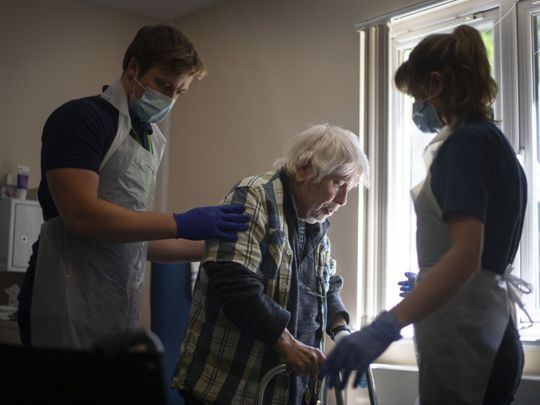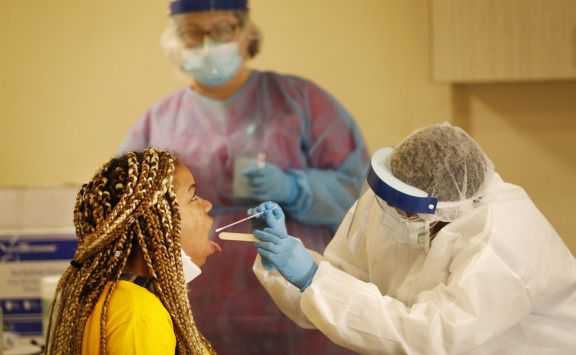
New York: In the time since the world’s scientists and public health officials first became widely aware of the new coronavirus in January, they’ve had six months to learn about it.
They’ve reached many conclusions about the virus and the illness it causes, from the importance of wearing masks to contain it, to the unusual range of symptoms it provokes.
But there are major gaps in scientific knowledge about the virus. In the half year that journalists have been reporting on Sars-CoV-2, there have emerged some enduring uncertainties. How scientists resolve some of these mysteries will shape our future with the coronavirus. Here are some of the things we don’t know yet:
How many people have been infected
One of the epidemic’s great unknowns is how many people have been infected so far.
According to a tally of official figures at 0550 GMT on Tuesday, more than 375,000 people have died worldwide from the novel coronavirus, mainly in the United States and Europe, since it emerged in China last year.
The deaths have come from a total of 6,258,474 cases, including 179,051 in Europe from 2,167,233 infections.
The United States has recorded the most deaths of any country, ahead of Britain, Italy, Brazil and France.
But only about 1.9 million Americans had tested positive as of May 28, according to the Centers for Disease Control and Prevention — or perhaps only about 1.7 million according to the Johns Hopkins Center for Health Security, which produces a frequently cited map of world cases.
Statisticians believe the actual number of cases is higher, but it is not clear by how much.
They have more confidence in the accuracy of data produced by states that do the most testing. On that score, New York is a leader; it has tested about 9.6 percent of its population, which is almost double the national average. (Rhode Island tested 13 percent of its people, beating New York, but its population is small.)
New York has also done tens of thousands of antibody tests for surveillance purposes. On May 22, Gov. Andrew Cuomo announced that, according to these tests, about a fifth of all New York City residents have had the virus, as had about 27 percent of thousands of black and Hispanic New Yorkers who were tested at their local churches.
If that same pattern were assumed to hold in other hard-hit big cities like Chicago, New Orleans, Detroit and Miami, it is likely that somewhere between 3 and 4 million urban Americans were infected.
The same holds true for almost every country around the world.
The amount of virus it takes to make you sick
Here’s what we can say for sure about the minimum number of viral particles it takes to seed a coronavirus infection: The number is somewhere between one and one million.
If you push scientists harder, they might offer a slightly smaller range of a few hundred to a few thousand — and some might even bravely throw out an estimate in the high hundreds, based on what they have learned about the behavior of the coronavirus that caused the 2002-03 SARS epidemic.
But the bottom line is that no one will know for sure until more research is completed. “It’s very unsatisfying to tell people, ‘Oh we don’t know,’” said Angela Rasmussen, a virologist at Columbia University in New York. “People do have a lot of questions about this.”
It’s difficult to say anything definitive about the coronavirus because it behaves like an influenza virus in how easily it is transmitted, and in that people can pass it on even when they don’t seem sick. But its structure, origin in bats and overall symptoms are similar to those of its cousin coronaviruses.
So scientists cannot say whether touching a surface with a smidgen of virus or breathing air with a few droplets exhaled by a sick person will make you ill. But it is safe to say exposure to more of the coronavirus is more likely to cause infection, and also to lead to more severe symptoms.
That’s why it’s important to avoid crowded indoor spaces, wear masks and wash your hands. Each of those steps can decrease your chances of being exposed to large amounts of virus.
Why some people get so much sicker than others
Covid-19 is a mercurial disease.
While some people experience only mild, fleeting symptoms, others are knocked over with a severe flulike illness that can last several weeks.
A minority of patients develop life-threatening complications. Death can ensue.
Why do some people sail through the illness, and others develop the severe inflammation and lung damage that are hallmarks of the disease? It is one of the great mysteries of Covid-19.
Experts say the patient’s immune response to the viral infection determines the severity of the illness. If the immune system goes into overdrive, it can trigger a cascade of harmful effects, injuring the lungs and other organs.
Immune function declines with age, and elderly people with Covid-19 are among the most vulnerable to poor outcomes, as are those with chronic health conditions like high blood pressure, diabetes and cardiovascular disease. Obesity, which affects 4 in 10 American adults, also appears to exacerbate the illness.
Men are at greater risk for critical illness and death, a sex disparity that may be explained by women’s more robust immune systems, scientists say.
The role of children in spreading the virus
There are many crucial unresolved questions about children and Covid-19. Finding the answers is not only important for them and their families, but for society at large, as communities plan to reopen schools, day care centers, playgrounds and other places children frequent.
One puzzle is what role children play in spreading the virus. They seem less likely to become seriously ill than adults, making up about 2 percent of confirmed American coronavirus cases. There are different theories about whether that is because children are less likely to become infected to begin with, or whether the virus infects them just as easily but mostly causes few or no symptoms.
body of evidence suggests that infected children can transmit the virus, possibly as easily as adults. And one recent study suggests that when children attend school, they come in contact with three times as many people as average adults do, providing more opportunities for children to become infected and infect others.
When or where the new coronavirus started spreading
The notion of a single patient zero is both theatrical and real: In any new epidemic, some unlucky soul seeds the first infection, several links of which are fated to seed chains of their own and spark a viral Big Bang.

By analyzing the genetic material of people who test positive, scientists can trace the lineage of each virus back to a common ancestor, and often to an individual carrier. The first confirmed coronavirus case in the United States was a man who landed at Seattle-Tacoma Airport on Jan. 15, from China. Other introductions came in February, and scientists are now closing in on who, exactly, sparked the outbreak in Washington State.
New York confirmed its first case on March 1, and by that time there were already thousands of infected people walking around, for a week or more. Scientist have found genetic signatures on the viruses studied so far that link them to Europe, likely brought in by some of the millions of people arriving in New York in February, and it is likely that there were multiple introductions that spread widely: patients zero, plural.
The first infected arrivals in a community are not necessarily the ones who light the fuse. In a report published last week, genetic scientists argued that infected people were among both Americans and Europeans in January, but that most of those viruses fizzled out. And French doctors recently reported that a respiratory sample from a man hospitalized near Paris, in late December, tested positive. That virus, too, likely died out. France’s outbreak did not start until many weeks later.
The world’s patient zero, in China, began infecting others in the late fall of last year, the evidence thus far suggests. An analysis of the first 41 confirmed cases, all in people who had visited the same seafood market in Wuhan, indicates that the first hospital admission was on Dec. 16, 2019. The patient first noticed symptoms on Dec. 1, so the infection dates back earlier. Several scientists have estimated that the first outbreak began in late or mid-November, and have inferred a probable common viral ancestor, though additional virus samples could change the picture.
The level of detective work required to find the actual patient zero might be steeper than it appears. At least one genetic scientist has argued that the virus could have first infected humans — likely from a pangolin — well before last fall, in a form that did not cause sickness. It then evolved its pathogenic features over time, while circulating. If that’s the case, the question “Who came first?” may go without a conclusive answer for some time, perhaps for good.
How long you’ll be immune after infection?
Are people infected with the coronavirus protected from further infection? And, if yes, for how long?
The answers to these questions have broad implications for reopening the economy and allowing the public to live with less fear of infection in the short term — and for the effectiveness of vaccines in the long term.
Scientists have made steady, if incremental, progress in getting to the answers. When the body encounters any virus, it typically makes antibodies, some of which are powerful enough to neutralize the pathogen and prevent reinfection. It also produces large numbers of immune cells that can kill the virus.
Most tests that look for antibodies to the coronavirus have been flawed. But at least one team with a reliable test reported that most people, including those who were only mildly ill, make powerful antibodies. Data on immune cells has been slower to emerge, but a few studies suggest a robust response from immune cells as well.
What remains unknown is how long this immunity will last.
There have been some reports of reinfection, but scientists have said that they are a result either of faulty testing, or of viral remnants that circulate long after the active infection has ended.
They are hopeful that based on other coronaviruses that cause the common cold, SARS or MERS, immunity to the new coronavirus might last at least a year, but it remains a mystery for now.








